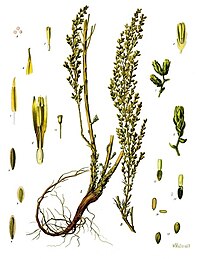
Photo from wikipedia
Abstract The low commercial production of artemisinin, the most potent anti-malarial compound, from leaves of Artemisia annua L. and other alternative methods are unable to fulfil its global needs. Therefore,… Click to show full abstract
Abstract The low commercial production of artemisinin, the most potent anti-malarial compound, from leaves of Artemisia annua L. and other alternative methods are unable to fulfil its global needs. Therefore, to look for other potential sources, the present study investigated and compared artemisinin contents in aerial tissues of four Artemisia species of Manipur (viz., A. parviflora, A. vulgaris L., A. myriantha and A. nilagarica) by UV-Spectrophotometry, which was further confirmed by RP-HPLC (reverse phase high performance liquid chromatography). Influence of extracting solvents, plant parts, growth stages and temperature for drying sample on artemisinin production were also investigated. Artemisinin content was highest in toluene extracts of flowers of A. vulgaris L. (0.091% per gram dry weight) followed by leaves of A. parviflora (0.087%). The present study also assessed the genetic relationship among the four Artemisia taxa for sustainable conservation and better understanding of the systematics of the genus, based on the analysis of three molecular markers:RAPD (random amplified polymorphic DNA), ISSR (inter-simple sequence repeat) and IRAP (inter-retrotransposon-microsatellite amplified polymorphism). High levels of polymorphism ( 80–105%) across the four taxa were observed for the three marker systems. The dendrogram generated from analysis of individual marker corresponded to the combination of the three molecular markers. The four Artemisia taxa were grouped into two clusters of section Artemisia (including A.nilagarica, A. myriantha and A. vulgaris) and section Dracunculus (including A.parviflora) showing delimitation of the studied taxa.
Journal Title: South African Journal of Botany
Year Published: 2019
Link to full text (if available)
Share on Social Media: Sign Up to like & get
recommendations!